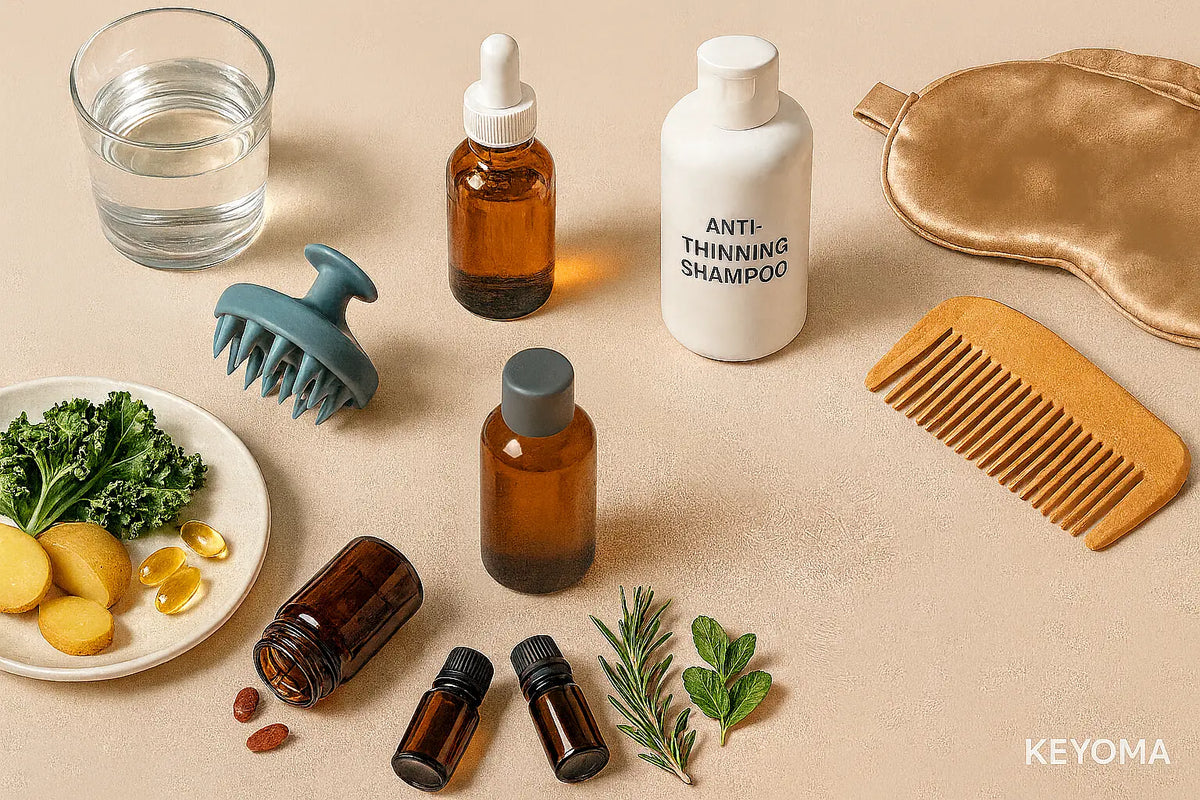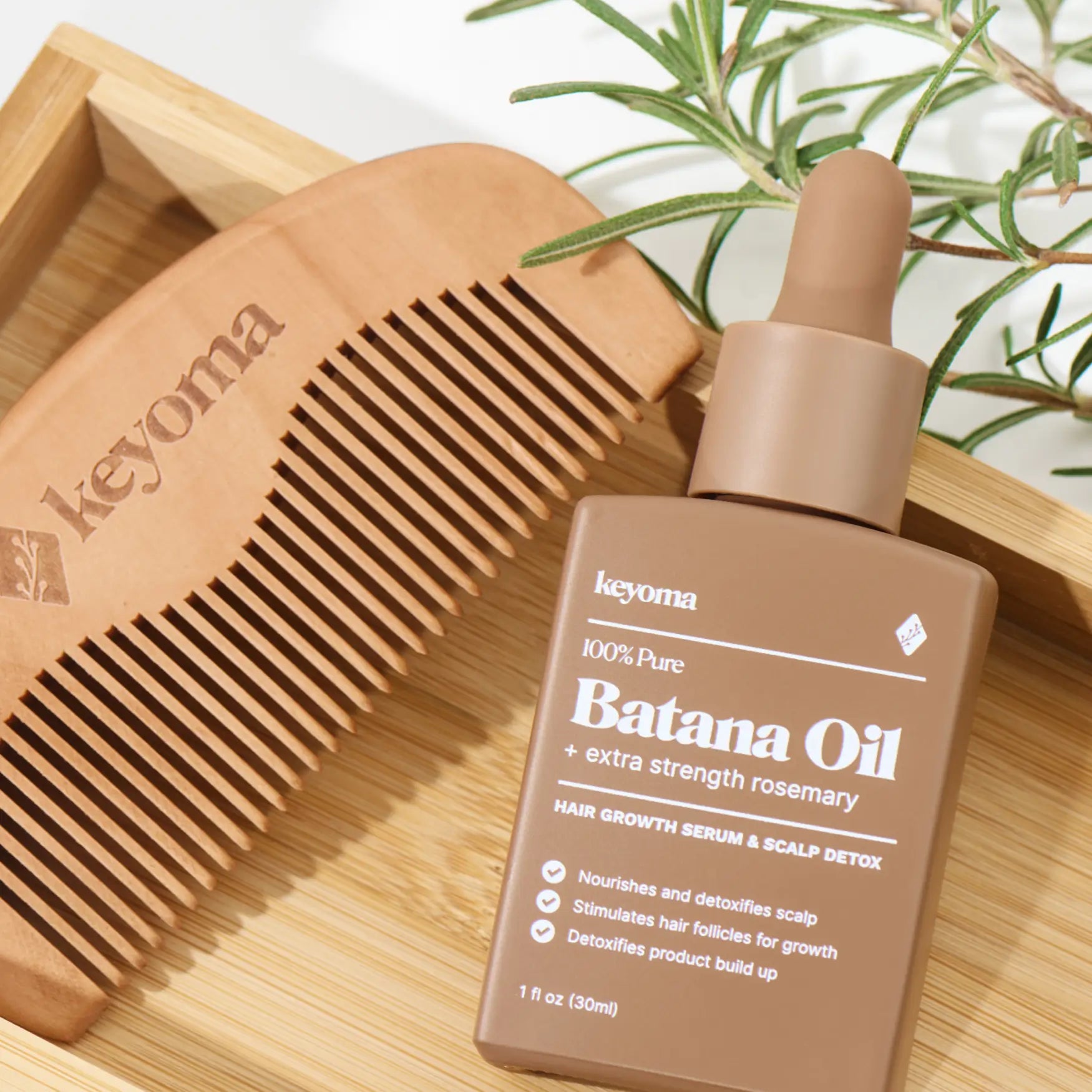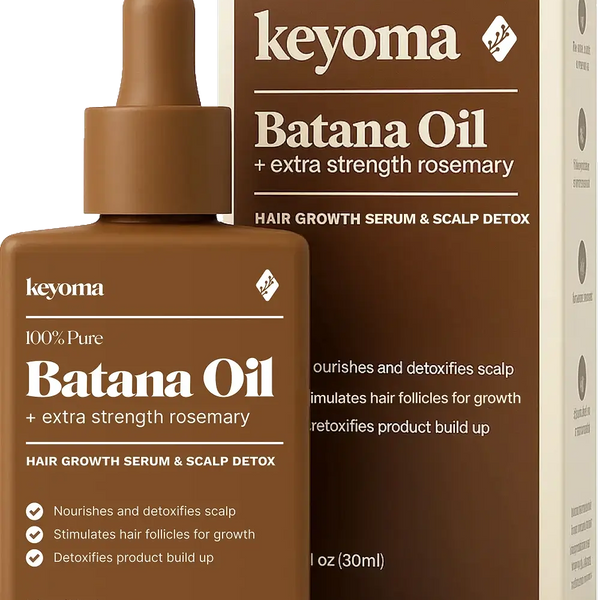In this article
Holistic hair growth is about approaching your hair journey as a whole-body process. It’s a mindset that sees your hair as a reflection of your internal health, not a separate issue you need to “fix.”
Unlike genetics, which you can’t control nor change, your holistic routine is entirely in your hands. Even if hair thinning runs in your family, supporting your scalp, nutrition, and hormonal balance can make a visible difference in how strong and active your follicles stay over time.
We can think of holistic hair growth as built on five key pillars:
-
Scalp health & circulation
-
Clinically proven treatments
-
Natural & botanical extracts
-
Nutrition & supplementation
-
Stress, sleep, & hormonal balance
Let’s get into it!
Key Takeaways
-
A healthy scalp with strong circulation, clear follicles, and balanced hydration is the base for real, long-term growth.
-
Consistent use of proven treatments like minoxidil or laser caps, paired with botanical oils such as rosemary or batana, yields the best results.
-
Balanced nutrition, steady sleep, and stress management directly affect how well your hair grows and how long it stays strong.
Pillar 1: Scalp Health & Circulation
A healthy scalp is the foundation of any true hair growth journey. It's built on three essentials:
-
Strong circulation keeps follicles well-fed and oxygenated so they stay active and capable of growth.
-
A clean surface removes buildup, oil, and residue that block follicles and slow nutrient flow.
-
Balanced hydration maintains the scalp’s natural barrier, keeping it resilient, supple, and comfortable.
Healthy scalp circulation sets the tone for every other pillar in holistic hair care. Once the base is strong, every nutrient, serum, and lifestyle habit you add will work twice as effectively.
Align your routine with these three principles by following the steps below
Scalp Massage for Hair Growth
Hair loss usually begins when the scalp stops getting enough blood flow. As circulation slows, follicles are deprived of oxygen and nutrients, leading them to shrink and eventually go dormant.
Scalp massage works by reversing that process.
It boosts microcirculation—the steady flow that brings life back to your follicles—helping them regain the energy needed for new growth. The result? Faster cell turnover and a healthier scalp environment where hair can thrive.
To get the most from scalp massage, keep these basics in mind:
-
Use your fingertips, not nails. Apply gentle circular motions for two to five minutes daily to stimulate the scalp without scratching it.
-
Add a nourishing oil. A few drops of rosemary‑infused batana oil or other botanical extracts (more on these later) hydrate the scalp and boost stimulation at the same time
-
Maintain light pressure. The massage should feel soothing, not aggressive; too much force can irritate or damage the skin.
-
Avoid over‑scrubbing or tugging. Rough handling can inflame follicles and do more harm than good.
Scalp Exfoliation and Cleanliness
Scalp exfoliation helps remove buildup that may otherwise clog follicles and "choke" them off of oxygen and nutrients. Overall, it supports a healthy microbiome, keeping inflammation and dandruff under control.
On top of that, without regular exfoliation, even the best serums and oils can’t sink in properly.
Here's what to do:
-
Use a gentle scalp scrub or chemical exfoliant once every one to two weeks, depending on how oily your scalp gets.
-
Pick mild acids (like lactic or salicylic acid) or soft botanical exfoliants instead of rough granules.
-
Massage gently with fingertips to loosen buildup without irritating the scalp.
What to avoid:
-
Don't scrub too hard or use coarse salt and sugar scrubs.
-
Don't exfoliate right after coloring, perming, or any chemical treatment.
-
Don't use harsh clarifying shampoos too often since they can strip essential oils and weaken your scalp barrier.
Hydration and pH Balance
Hydration and pH balance go hand in hand in creating the right environment for steady hair growth. When your scalp is well‑hydrated, circulation improves, nutrients move freely, and the follicles stay elastic enough to keep producing healthy strands
On the other hand, a dry scalp constricts blood flow, leading to irritation, micro‑cracks, and breakage near the roots.
As for pH, the scalp’s natural pH sits slightly acidic, around 4.5 to 5.5. This acidity maintains the skin barrier, keeping the microbiome balanced and protecting follicles from bacterial overgrowth or inflammation that can interrupt growth cycles.
When that balance tips (often from harsh shampoos or overwashing), the barrier weakens and moisture loss speeds up.
What to do:
-
Choose sulfate‑free shampoos and moisturizing conditioners that help retain natural oils.
-
Use leave‑in tonics or lightweight oils that keep hydration locked in without suffocating follicles.
-
If your scalp feels tight or squeaky after washing, switch to a gentler formula.
What to avoid:
-
Don't over‑wash since this strips the scalp of its natural lipids and throws off the pH balance.
-
Don't use strong alkaline or clarifying shampoos too often (we discussed this in the earlier section)
-
Don't ignore early signs of imbalance such as flaking, redness, or that dry, stretched feeling after cleansing.
Pillar 2: Clinically Proven Treatments
If you ask most hair professionals where to begin on a hair growth plan, they’ll likely point you toward clinically proven, FDA‑approved treatments.
These aren’t your typical “natural” options but medications and devices backed by years of research and clinical trials showing measurable regrowth.
That's to say these are the options you can really count on when you want your follicles to start working overtime again.
Here are the top options:
-
Minoxidil: A topical vasodilator that widens blood vessels around follicles to improve circulation and nutrient delivery, extending the growth phase (anagen) of hair.
-
Finasteride: An oral medication that blocks the conversion of testosterone to DHT, the hormone most responsible for androgenetic alopecia (pattern baldness).
-
Ritlecitinib: One of the newest FDA‑approved oral treatments, this drug works to calm autoimmune activity linked to alopecia areata.
Aside from medication, another clinically proven treatment now gaining attention is low‑level laser therapy (LLLT), commonly used in laser caps or combs.
These devices emit red light at specific wavelengths that penetrate the scalp to stimulate follicle activity, improve blood flow, and encourage dormant follicles to re‑enter the growth phase.
Pillar 3: Natural & Botanical Extracts
Natural and botanical remedies have been part of hair care for centuries, with many of which coming from Ayurvedic, African, and traditional herbal practices.
They work not by altering hormones or forcing growth, but by nourishing the scalp, calming inflammation, and restoring the environment that allows follicles to thrive naturally.
Popular natural extracts for hair growth (and the ones I can personally vouch for) include:
-
Rosemary oil: improves blood circulation to the scalp and has been clinically compared to minoxidil for promoting regrowth.
-
Coconut oil: deeply moisturizes and protects the hair shaft, reducing protein loss and breakage
-
Batana oil: rich in oleic and linoleic acids that repair and nourish damaged hair.
-
Bee venom: helps stimulate dermal papilla cells and growth factors that reawaken dormant follicles.
-
Aloe vera: soothes scalp irritation, supports hydration, and maintains a balanced pH for healthy follicles.
-
Jojoba oil: mimics the scalp’s natural sebum, making it perfect for balancing moisture without clogging pores.
Pillar 4: Nutrition & Supplement Support
We don’t realize it often enough, but the length, shine, and strength of your hair are reflections of your diet. That’s why nutrition plays such a key role in holistic hair growth. Because no matter what products you use, your strands can only grow as healthy as what’s fueling them from within.
Hair follicles are among the fastest-growing cells in your body, which means they depend on a steady flow of nutrients to keep producing new strands. When your diet falls short, your body naturally prioritizes vital organs first, and your hair ends up being last priority.
Below are the nutrients essential for healthy hair growth and what happens when they’re missing:
-
Protein: The building block of keratin. Too little can leave hair brittle and weak.
-
Iron: Delivers oxygen to follicles. Low iron or ferritin levels are linked to shedding.
-
Zinc: Keeps follicle tissue strong and oil glands balanced. Deficiency slows growth and causes thinning.
-
Vitamin D: Regulates follicle cycling. Low levels can trigger telogen effluvium or excess shedding.
-
Vitamin C: Boosts collagen and helps your body absorb iron efficiently.
-
Omega-3 fatty acids: Calm inflammation and support the scalp’s moisture barrier.
-
Biotin and B-complex vitamins: Strengthen the shaft and improve density over time.
I’ve covered the best foods for hair growth in a previous article, so you’ll know which foods can help you get these nutrients.
And here’s what to avoid—or at least be mindful of:
-
Crash diets or extreme calorie restriction, which shock the body and trigger temporary hair loss.
-
Highly processed foods loaded with sugar and trans fats that fuel inflammation and affect scalp balance.
-
Excessive alcohol or caffeine, which can dehydrate the scalp and block nutrient absorption.
-
Over-supplementing, since too much of certain vitamins (like vitamin A or selenium) can ironically cause shedding.
Pillar 5: Stress, Sleep & Hormonal Balance
Another thing we rarely think about, but has a great impact on our hair growth journeys, is stress and sleep quality.
Those late-night work sessions, all-nighters on your phone, or weeks spent anxious over deadlines might not seem like much at first. But stretch that pattern long enough, and you’ll start to notice more hair in your brush or shower drain.
When you’re stressed, your body releases cortisol, a hormone that can disrupt the natural growth cycle by pushing follicles into the resting (telogen) phase prematurely.
Chronic stress also throws off hormonal balance, raising inflammation and reducing the body’s ability to absorb and circulate nutrients efficiently.
You can bring things back into balance with small, consistent changes:
-
Prioritize at least 7–8 hours of quality sleep per night to help regulate cortisol and hormonal rhythms.
-
Try daily relaxation techniques such as deep breathing, meditation, or short walks to reduce stress response.
-
Keep a consistent sleep schedule to align with your natural circadian rhythm, which supports cell renewal and follicle activity.
And here's what to avoid:
-
Relying on caffeine or energy drinks to power through fatigue, which worsens hormonal disruption.
-
Skipping meals or working through lunch. Unstable blood sugar levels heighten cortisol production.
-
Scrolling on your phone or watching screens late into the night; the blue light suppresses melatonin, your sleep hormone.
Final Thoughts: It's Never Just One Thing
Healthy hair doesn’t come from one magic product or a single habit. It’s the mix of everything, from keeping your scalp fresh and clean, to feeding your body right, managing stress, and staying consistent with what truly works for you.
For me, that means staying loyal to my rosemary and batana oil blend. I’ve been using it for years to keep my strands soft, strong, and shiny. But beyond that, I’ve also been paying closer attention to my diet and sleep, even if they’re not as easy to stick with.
What about you? What part of your routine are you working on right now?
If you want more tips, routines, and ingredient breakdowns that actually work, head over to the Keyoma blog. You’ll find plenty there to keep your hair journey going strong.
Featured Product
100% Pure Batana Oil + Rosemary









